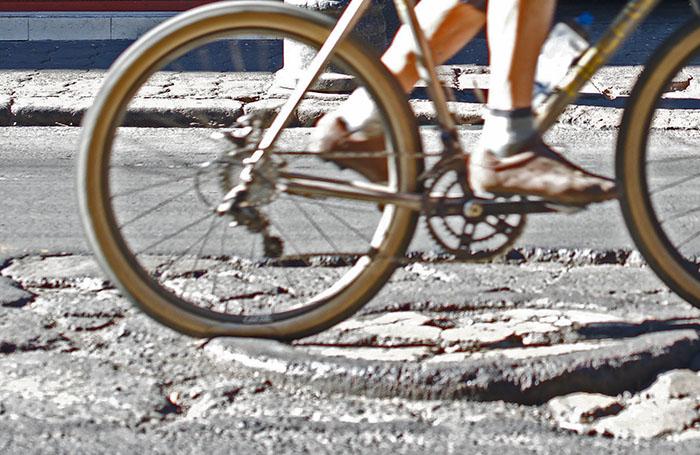Why Supple Tires Run at Higher Pressures

One of the benefits of wide tires is that they run at lower pressures. Yet the supple casings of our Rene Herse tires require higher pressure to corner well and not bottom out on big bumps. Doesn’t the higher pressure negate the benefits of wider tires?

Think of the tire casing and the air inside as two separate springs. Let’s call them the rubber spring and the air spring. Both work together to support the weight of the rider. How you distribute the load between the two springs changes with a supple tire: Less rubber requires more air. And vice versa.
When you inflate your tire, you are aiming for a tire drop of about 15-20%. (Tire drop is how much the tire deforms under the rider’s weight.) Whether you use rubber or air as the spring doesn’t change how much the tire deflects. What changes is how the tire behaves as it flexes.

On tires with stiff casings, you use rubber as your suspension, and you need little air. The extreme case are airless tires. They use only rubber and foam to support the bike and rider. However, rubber has a lot of hysteresis, so it consumes a lot of energy as it flexes. That is why stiff tires are slow.
A tire with a supple casing (above) relies mostly on air to support the weight of bike and rider. Air has almost no hysteresis: Little energy is lost as the tire flexes. That is part of the secret behind the speed of supple tires.

A supple tire is more comfortable, too. The thinner casing has less inertia and requires less energy to flex, so it can react more quickly to surface irregularities. A supple tire absorbs the vibrations, while a stiff tire transmits them to the bike and rider. And since vibrations slow you down, that makes the supple tire faster, too.
So you gain speed twice: the thinner casing absorbs less energy (smaller hysteretic losses) and it transmits fewer vibrations (smaller suspension losses). Talk about a win-win situation!

It’s important to remember that supple tires need more air to hold up your bike. After all, you’ve reduced the spring rate (stiffness) of the rubber spring, and you need to make up for this by increasing the spring rate of the air spring. If you run your supple tires at the same pressure as stiffer ones, you risk having the sidewalls collapse during hard cornering. And that can be dangerous.
Put in a little more air, and you’ll find that supple tires offer more grip than stiff ones: The supple casing reacts better to surface irregularities and thus keeps the tire in better contact with the road. There is no need to go back to the days when we inflated our tires to the maximum indicated on the sidewall. Use the Tire Pressure Calculator (linked in the top menu) as a starting point, and experiment from there.

On gravel and in mud, there is less traction, and thus the forces on the tire are lower. The tires won’t collapse even if you run very low pressures. On soft surfaces, you get more traction, more comfort and more speed at those low pressures.
Generally, I run about 15-20% less air in my tires on gravel than I do on pavement. You don’t want to run a pressure that is too low – it flexes the tire sidewalls excessively, which robs power and ultimately breaks the fine threads that make up the casing. And of course, you don’t want to bottom out except on rare occasions, even when running tubeless tires.
Also remember that the gauges on bicycle floor pumps are notoriously inaccurate, so if you pump up your tires to the pressures from the chart and your bike doesn’t feel right, trust your feel rather than your gauge.
Conclusion: Even though supple tires run at higher pressures, they are faster, more comfortable and grip better than tires with stiff casings. The ‘correct’ tire pressure should have some margin of safety above the point where the tire collapses during hard cornering.


